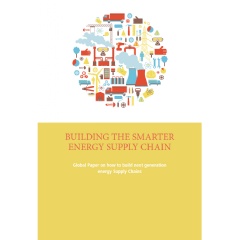Transformed energy sector demands a smarter supply chain
- DHL white paper analyses new supply chain requirements for energy sector
- Shifting geographies of energy demand and production require end-to-end logistics solution to increase visibility and reliability
DHL today issued a new white paper on energy companies and their supply chain design. It endorses logistics executives to rethink traditional energy supply chain models and implement a highly integrated approach, before logistics drive up costs and destroy profit margins. The report is based on research by Lisa Harrington, President of the lharrington group LLC and Associate Director at the Supply Chain Management Center of the Robert H. Smith School of Business, University of Maryland. It advocates a ’smarter’ energy supply chain: an orchestrated, data-driven, end-to-end model that increases visibility, reliability, and keeps costs as well as risk down.
“The ongoing shift in geographies of energy production and demand require energy companies to adjust their supply chain management. Particularly for unconventional oil extraction, the logistics infrastructure is not mature. Choreographing upstream, inbound, outbound, emergency and worker supply chains is highly complex and challenging - working with an experienced lead logistics provider (LLP) can be very beneficial, as other industries show”, says Steve Harley, President, DHL Energy Sector, DHL Customer Solutions & Innovation.
The oil and gas industry is undergoing fundamental changes, driven by the development of new unconventional energy sources such as shale gas, tight oils, liquefied natural gas, and oil sands. The BP Energy Outlook 2030 predicts that shale gas production will triple, and that tight oil production will increase more than six-fold by 2030. Unlike conventional oils though, unconventional extraction demands higher and continuous investment. The Eagle Ford Shale field in South Texas has more than 250 rigs for example, for which over 6,000 wells needed to be drilled. In addition, the world’s oil supplies no longer remain concentrated in the Middle East, Africa and Russia, and production often needs to be developed in remote areas.
Executives quoted in the white paper admit that energy companies often struggle to deal with the complexity of the supply chain and that they are challenged by a lack of visibility and predictability when they are working with multiple stakeholders at numerous drilling locations. Consequently, they often encounter issues with managing health, safety, security and environment, and grapple with data management to measure performance. As a result, companies compensate risk by maintaining high inventory levels and using cost-intensive ad-hoc air charter services to have items on site.
According to Lisa Harrington, an end-to-end supply chain model including a control tower function tackles these challenges: “The approach is highly successful in other industries such as the automotive sector, for example. There, the supply chain is a competitive differentiator for businesses, because it increases agility and reduces costs and risk. Energy companies need to ask themselves if they want to invest in the infrastructure and staff a global, well-running, integrated supply chain requires, or if they prefer to outsource this to third party logistics providers steered by a LLP.”
Besides the current state of the energy industry, its impact on the supply chain and emerging solutions, the white paper also includes a best practice case from the Sechuan basins in China. The full report is available at http://www.dhl.com/smartenergysupplychain.
( Press Release Image: https://photos.webwire.com/prmedia/7/192449/192449-1.jpg )
WebWireID192449
This news content was configured by WebWire editorial staff. Linking is permitted.
News Release Distribution and Press Release Distribution Services Provided by WebWire.
